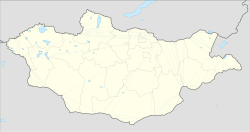Ölgii (city)
|
Ölgii Өлгий ᠥᠯᠦᠭᠡᠢ |
|
|---|---|
| District | |
|
Ölgii District Өлгий сум ᠥᠯᠦᠭᠡᠢᠰᠤᠮᠤ |
|
| Official Cyrillic transcription(s) | |
| • Mongolian Cyrillic | Өлгий сум |
| Classical Mongolian transcription(s) | |
| • Mongolian script | ᠥᠯᠦᠭᠡᠢᠰᠤᠮᠤ |

Ölgii city
|
|
| Location in Mongolia | |
| Coordinates: 48°58′06″N 89°58′07″E / 48.96833°N 89.96861°ECoordinates: 48°58′06″N 89°58′07″E / 48.96833°N 89.96861°E | |
| Country |
|
| Province | Bayan-Ölgii |
| Area | |
| • Total | 15 km2 (6 sq mi) |
| Elevation | 1,710 m (5,610 ft) |
| Population (2008) | |
| • Total | 28,496 |
| • Density | 1,500/km2 (4,000/sq mi) |
| Time zone | UTC+7 |
| Area code(s) | +976 (0)142 |
| License plate | БӨ_ (_variable) |
Ölgii (Mongolian: Өлгий cradle) is the capital of the Bayan-Ölgii Aimag (province) of Mongolia, located in the extreme west of the country. It lies on an altitude of 1,710 meters (5,610 feet). City population is 28,496 (2008).
The center of the predominantly Kazakh region of Mongolia, Kazakh is the primary language spoken in Ölgii. The city is home to at least 4 mosques. The city is known for its Kazakh embroidery and art, Kazakh music, and hunting with eagles. Each October, Ölgii hosts the annual Golden Eagle Festival which showcases the ancient Kazakh custom of eagle hunting.
Ölgii was an ethnic Kazakh village before the founding of the modern nation of Mongolia in 1911. Kazakhs have been coming to the Altai region of Mongolia for at least 200 years. Many came as Kazakhs faced pressure from the expanding Russian Empire. These numbers increased significantly after the 1917 Russian Revolution and the rise of communism in China. It was the center of Islam in Mongolia before religious purges in the 1930s in which the mosque was destroyed and the imam was executed. Mongolia initially tried to suppress Kazakh language and culture before creating Bayan-Ölgii Aimag in 1939, with Ölgii as the seat of government. Much of the center of the city was built in the 1950s to 1980s. Ölgii developed less than the rest of Mongolia and was not connected by railroad or paved road due to its isolated location and lack of mineral resources. After the Mongolian democratic revolution in 1991 and the breakup of the Soviet Union, 25% of the population moved to the newly independent Kazakhstan. Though, many later returned and the population has largely recovered. In recent years construction has increased significantly resulting in many new apartments, shops, restaurants, and hotels (most have been built since 2005), mirroring a construction boom throughout Mongolia.
Like other post-communist cities, much of the industry closed down in the 1990s, though a large wool factory and many smaller animal related factories continue to process products from the 2 million animals in the Aimag.
...
Wikipedia

